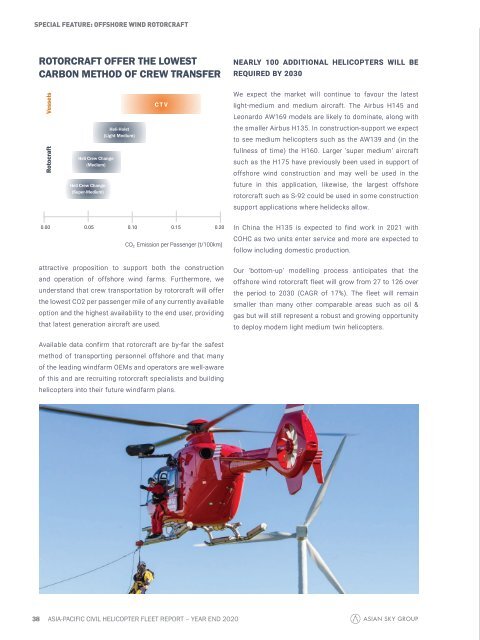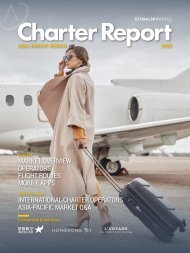Helicopter Fleet Report - YE2020
Create successful ePaper yourself
Turn your PDF publications into a flip-book with our unique Google optimized e-Paper software.
SPECIAL FEATURE: OFFSHORE WIND ROTORCRAFT<br />
ROTORCRAFT OFFER THE LOWEST<br />
CARBON METHOD OF CREW TRANSFER<br />
NEARLY 100 ADDITIONAL HELICOPTERS WILL BE<br />
REQUIRED BY 2030<br />
Rotocraft Vessels<br />
Heli Crew Change<br />
(Medium)<br />
Heli-Hoist<br />
(Light Medium)<br />
CTV<br />
We expect the market will continue to favour the latest<br />
light-medium and medium aircraft. The Airbus H145 and<br />
Leonardo AW169 models are likely to dominate, along with<br />
the smaller Airbus H135. In construction-support we expect<br />
to see medium helicopters such as the AW139 and (in the<br />
fullness of time) the H160. Larger ‘super medium’ aircraft<br />
such as the H175 have previously been used in support of<br />
offshore wind construction and may well be used in the<br />
Heli Crew Change<br />
(Super-Medium)<br />
future in this application, likewise, the largest offshore<br />
rotorcraft such as S-92 could be used in some construction<br />
support applications where helidecks allow.<br />
0.00 0.05 0.10 0.15 0.20<br />
CO 2 Emission per Passenger (t/100km)<br />
In China the H135 is expected to find work in 2021 with<br />
COHC as two units enter service and more are expected to<br />
follow including domestic production.<br />
attractive proposition to support both the construction<br />
and operation of offshore wind farms. Furthermore, we<br />
understand that crew transportation by rotorcraft will offer<br />
the lowest CO2 per passenger mile of any currently available<br />
option and the highest availability to the end user, providing<br />
that latest generation aircraft are used.<br />
Our ‘bottom-up’ modelling process anticipates that the<br />
offshore wind rotorcraft fleet will grow from 27 to 126 over<br />
the period to 2030 (CAGR of 17%). The fleet will remain<br />
smaller than many other comparable areas such as oil &<br />
gas but will still represent a robust and growing opportunity<br />
to deploy modern light medium twin helicopters.<br />
Available data confirm that rotorcraft are by-far the safest<br />
method of transporting personnel offshore and that many<br />
of the leading windfarm OEMs and operators are well-aware<br />
of this and are recruiting rotorcraft specialists and building<br />
helicopters into their future windfarm plans.<br />
38 ASIA-PACIFIC CIVIL HELICOPTER FLEET REPORT – YEAR END 2020

















